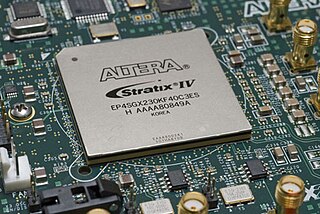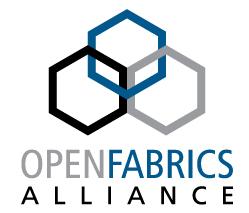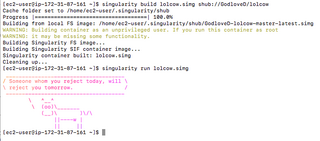
A field-programmable gate array (FPGA) is a type of configurable integrated circuit that can be programmed or reprogrammed after manufacturing. FPGAs are part of a broader set of logic devices referred to as programmable logic devices (PLDs). They consist of an array of programmable logic blocks and interconnects that can be configured to perform various digital functions. FPGAs are commonly used in applications where flexibility, speed, and parallel processing capabilities are required, such as in telecommunications, automotive, aerospace, and industrial sectors.

InfiniBand (IB) is a computer networking communications standard used in high-performance computing that features very high throughput and very low latency. It is used for data interconnect both among and within computers. InfiniBand is also used as either a direct or switched interconnect between servers and storage systems, as well as an interconnect between storage systems. It is designed to be scalable and uses a switched fabric network topology. Between 2014 and June 2016, it was the most commonly used interconnect in the TOP500 list of supercomputers.
Cray Inc., a subsidiary of Hewlett Packard Enterprise, is an American supercomputer manufacturer headquartered in Seattle, Washington. It also manufactures systems for data storage and analytics. Several Cray supercomputer systems are listed in the TOP500, which ranks the most powerful supercomputers in the world.

Quadrics was a supercomputer company formed in 1996 as a joint venture between Alenia Spazio and the technical team from Meiko Scientific. They produced hardware and software for clustering commodity computer systems into massively parallel systems. Their highpoint was in June 2003 when six out of the ten fastest supercomputers in the world were based on Quadrics' interconnect. They officially closed on June 29, 2009.
In computing, remote direct memory access (RDMA) is a direct memory access from the memory of one computer into that of another without involving either one's operating system. This permits high-throughput, low-latency networking, which is especially useful in massively parallel computer clusters.

Altix is a line of server computers and supercomputers produced by Silicon Graphics, based on Intel processors. It succeeded the MIPS/IRIX-based Origin 3000 servers.

QLogic Corporation was an American manufacturer of networking server and storage networking connectivity and application acceleration products, based in Aliso Viejo, California through 2016. QLogic's products include Fibre Channel adapters, converged network adapters for Fibre Channel over Ethernet (FCoE), Ethernet network interface controllers, iSCSI adapters, and application-specific integrated circuits (ASICs). It was a public company from 1992 to 2016.
The Texas Advanced Computing Center (TACC) at the University of Texas at Austin, United States, is an advanced computing research center that is based on comprehensive advanced computing resources and supports services to researchers in Texas and across the U.S. The mission of TACC is to enable discoveries that advance science and society through the application of advanced computing technologies. Specializing in high performance computing, scientific visualization, data analysis & storage systems, software, research & development and portal interfaces, TACC deploys and operates advanced computational infrastructure to enable the research activities of faculty, staff, and students of UT Austin. TACC also provides consulting, technical documentation, and training to support researchers who use these resources. TACC staff members conduct research and development in applications and algorithms, computing systems design/architecture, and programming tools and environments.

The OpenFabrics Alliance is a non-profit organization that promotes remote direct memory access (RDMA) switched fabric technologies for server and storage connectivity. These high-speed data-transport technologies are used in high-performance computing facilities, in research and various industries.

Fabric computing or unified computing involves constructing a computing fabric consisting of interconnected nodes that look like a weave or a fabric when seen collectively from a distance.

Chelsio Communications is a privately held technology company headquartered in Sunnyvale, California with a design center in Bangalore, India. Early venture capital funding came from Horizons Ventures, Invesco, Investor Growth Capital, NTT Finance, Vendanta Capital, Abacus Capital Group, Pacesetter Capital Group, and New Enterprise Associates. A third round of funding raised $25 million in late 2004. LSI Corporation was added as investor in 2006 in the series D round. By January 2008, a $25M financing round was announced as series E. In 2009, an additional $17M was raised from previous investors plus Mobile Internet Capital.
RDMA over Converged Ethernet (RoCE) or InfiniBand over Ethernet (IBoE) is a network protocol which allows remote direct memory access (RDMA) over an Ethernet network. It does this by encapsulating an InfiniBand (IB) transport packet over Ethernet. There are multiple RoCE versions. RoCE v1 is an Ethernet link layer protocol and hence allows communication between any two hosts in the same Ethernet broadcast domain. RoCE v2 is an internet layer protocol which means that RoCE v2 packets can be routed. Although the RoCE protocol benefits from the characteristics of a converged Ethernet network, the protocol can also be used on a traditional or non-converged Ethernet network.

Xeon Phi is a discontinued series of x86 manycore processors designed and made by Intel. It was intended for use in supercomputers, servers, and high-end workstations. Its architecture allowed use of standard programming languages and application programming interfaces (APIs) such as OpenMP.

Mellanox Technologies Ltd. was an Israeli-American multinational supplier of computer networking products based on InfiniBand and Ethernet technology. Mellanox offered adapters, switches, software, cables and silicon for markets including high-performance computing, data centers, cloud computing, computer data storage and financial services.
Bright Computing, Inc. is a developer of software for deploying and managing high-performance (HPC) clusters, Kubernetes clusters, and OpenStack private clouds in on-premises data centers as well as in the public cloud.
The Gen-Z Consortium is a trade group of technology vendors involved in designing CPUs, random access memory, servers, storage, and accelerators. The goal was to design an open and royalty-free "memory-semantic" bus protocol, which is not limited by the memory controller of a CPU, to be used in either a switched fabric or a point-to-point device link on a standard connector.

Singularity is a free and open-source computer program that performs operating-system-level virtualization also known as containerization.
Compute Express Link (CXL) is an open standard for high-speed, high capacity central processing unit (CPU)-to-device and CPU-to-memory connections, designed for high performance data center computers. CXL is built on the serial PCI Express (PCIe) physical and electrical interface and includes PCIe-based block input/output protocol (CXL.io) and new cache-coherent protocols for accessing system memory (CXL.cache) and device memory (CXL.mem). The serial communication and pooling capabilities allows CXL memory to overcome performance and socket packaging limitations of common DIMM memory when implementing high storage capacities.
Inspur Server Series is a series of server computers introduced in 1993 by Inspur, an information technology company, and later expanded to the international markets. The servers were likely among the first originally manufactured by a Chinese company. It is currently developed by Inspur Information and its San Francisco-based subsidiary company - Inspur Systems, both Inspur's spinoff companies. The product line includes GPU Servers, Rack-mounted servers, Open Computing Servers and Multi-node Servers.

Leonardo is a petascale supercomputer located at the CINECA datacenter in Bologna, Italy. The system consists of an Atos BullSequana XH2000 computer, with close to 14,000 Nvidia Ampere GPUs and 200 Gbit/s Nvidia Mellanox HDR InfiniBand connectivity. Inaugurated in November 2022, Leonardo is capable of 250 petaflops, making it one of the top five fastest supercomputers in the world. It debuted on the TOP500 in November 2022 ranking fourth in the world, and second in Europe.












